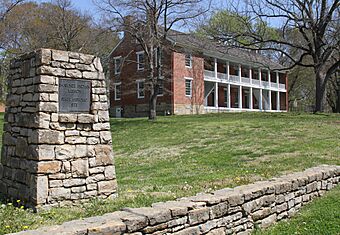Shawnee Methodist Mission facts for kids
|
Shawnee Mission
|
|

The historic site in 2021
|
|
| Location | 3403 W. 53rd Street, Fairway, Kansas |
|---|---|
| Area | 12 acres (4.9 ha) |
| Built | 1839 |
| NRHP reference No. | 66000345 |
Quick facts for kids Significant dates |
|
| Added to NRHP | October 15, 1966 |
| Designated NHL | May 23, 1968 |
The Shawnee Methodist Mission, also known as the Shawnee Mission, is a very old and important place in Fairway, Kansas, United States. It was once a school for Native American children. Today, it is a museum where you can learn about its history.
This site is so important that it was named a National Historic Landmark in 1968. The Kansas Historical Society owns it, and the city helps run it as the Shawnee Indian Mission State Historic Site.
For a short time, the Shawnee Indian Manual Labor Boarding School was even the second capital of the Kansas Territory. This happened when lawmakers who supported slavery were in charge. The building was the capital from July 16 to August 7, 1855.
The name "Shawnee Mission" is still used today. It refers to many towns near Kansas City in Johnson County. The Shawnee Mission School District also serves these communities.
Contents
History of the Shawnee Mission
The First Shawnee Indian Mission
In the 1820s and 1830s, many Native American tribes, including the Shawnee, moved to what is now Kansas. In 1830, Chief Fish, a Shawnee leader, asked for a missionary. Reverend Thomas Johnson, a Methodist minister, was chosen to help the Shawnees.
Reverend Johnson was born in Virginia. He later moved to Missouri. He owned enslaved people and supported slavery. Johnson suggested building a school for many different tribes. They chose a spot west of Missouri. This area was where the Santa Fe, California, and Oregon Trails crossed through Shawnee lands.
A New School Opens
The school first opened in October 1839. It started as a day school with one building. This building is now called the West building. At its busiest time, the mission was huge. It covered more than 2,000 acres (810 ha) of land.
There were 16 buildings in total. Three large brick buildings still stand today. Nearly 150 Native American boys and girls attended the school. They ranged in age from 5 to 23. Children from 22 different tribes came here. They learned basic school subjects, English, and practical skills like farming.
The East building was used as the main chapel. It also had classrooms for boys. The attic was a dormitory for the boys. The North building was where the girls had their classrooms and bedrooms.
Changes in Kansas Territory
In 1854, the Kansas Territory was created. Andrew Reeder became the new governor. His offices were at the mission. The first group of lawmakers for the territory met there. Reverend Johnson was even the president of this group.
During this time, some very unfair laws were passed. These laws were meant to keep slavery in Kansas. In 1858, Reverend Thomas Johnson gave the school to his oldest son, Alexander. Alexander ran the mission until it closed in 1862.
The mission closed during a time of fighting called "Bleeding Kansas" and the "border wars." It was used as a camp for Union soldiers during the Civil War until 1864. The site was private property for many years. Then, in 1927, the Kansas State Historical Society bought it. It became a state historic site. In 1968, it was named a National Historic Landmark.
The Shawnee People
The "Fish" Shawnee tribe had to move from their home in Ohio. They moved to lands set aside for Native Americans in what would become Kansas. This move happened because of the Treaty of St. Louis (1825). The mission was first built near the American Shawnee Indian Tribe reserve. Reverend Thomas Johnson built it. He hoped to teach the recently moved tribe about Christianity.
In the 1830s, important Shawnee leaders visited the mission often. One of them was Tenskwatawa, known as "the Shawnee Prophet." He was the younger brother of Tecumseh. Tecumseh had led a war against the United States earlier. Tenskwatawa led the Shawnee in Tecumseh's absence at the Battle of Tippecanoe in 1811.
After losing this battle, Tenskwatawa and his men went to the British Canadian colonies. He was kept under watch for years after the War of 1812 ended. Tenskwatawa was later allowed to return to the Shawnee. He helped them move from Ohio to Kansas. He passed away in 1836 in his village. This village is now Kansas City, Kansas.
The Mission's New Location
The mission was at its first location from 1830 to 1839. In 1839, the mission moved to its current spot in Johnson County. An Indian boarding school opened there. From 1839 until it closed in 1862, the Shawnee Mission was a training school. It taught Native Americans, mainly from the Shawnee and Delaware tribes.
The Shawnee Mission also served as the second capital of the Kansas Territory for a short time. The capital moved to the mission on July 16, 1855. This happened after lawmakers who supported slavery voted to leave the first Territorial Capitol of Kansas at Pawnee. It was the capital until August 8, when the government moved to Lecompton.
While the capital was at Shawnee Mission, the lawmakers passed laws that supported slavery. These laws caused the violence known as Bleeding Kansas. During the American Civil War, the site was used as a camp for Union soldiers.
How the Mission is Managed
The City of Fairway helps manage the Shawnee Mission. They work with the Kansas Historical Society, which owns the site. It was named a National Historic Landmark in 1968.
Gallery
See also









